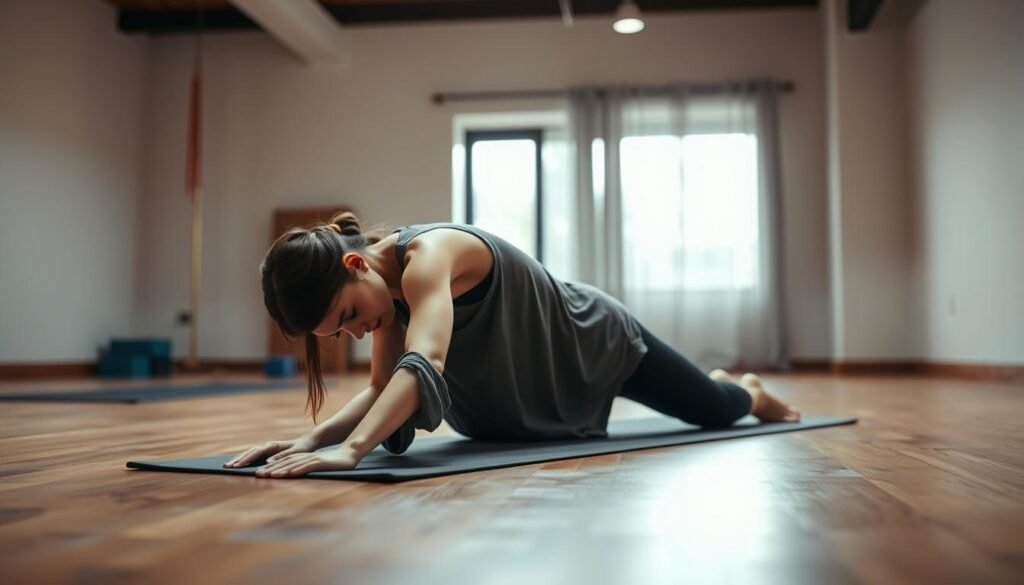Have you ever wondered why your back feels stiff after hours of sitting? In today’s world, many of us spend most of our time at desks or on couches. This sedentary lifestyle can take a toll on our body, especially our spine and shoulders.
Prolonged sitting often leads to muscle stiffness and imbalances. Over time, this can cause discomfort in your neck and back, affecting your overall health. But the good news is, there’s a simple way to counteract these effects.
We’ve curated three science-backed moves to help you reset your alignment and feel better in just a few minutes. These exercises require no equipment and can be done anywhere. By practicing them consistently, you’ll notice reduced pain, improved breathing, and better spinal alignment.
Ready to take the first step toward a healthier, more comfortable you? Let’s dive into these easy-to-follow moves and transform the way you feel after sitting for long periods.
Key Takeaways
- Prolonged sitting can cause stiffness and discomfort in your back, neck, and shoulders.
- Three simple moves can help reset your alignment and reduce pain.
- These exercises are quick, effective, and require no equipment.
- Consistent practice improves spinal alignment and breathing.
- These moves are accessible and can be done anywhere, anytime.
Why Posture Reset Matters After Prolonged Sitting
Sitting for hours can silently harm your body in ways you might not notice. Over time, it reverses the natural curves of your spine, leading to discomfort and long-term issues. When your head tilts forward, it adds extra pressure—up to 10 pounds per inch—straining your neck and shoulders.
This phenomenon, often called “text neck,” is common with device usage. It compresses discs and tightens muscles, causing aches in your lower back and beyond. Poor alignment doesn’t just affect your body—it impacts your mental health too. Studies show it can reduce confidence and limit breathing capacity.
Research from the Cleveland Clinic highlights the connection between posture and emotions. Slouching can make you feel less energetic and more stressed. Imagine carrying a 10-pound bowling ball all day—that’s what your head feels like when it’s out of alignment.
Muscle memory plays a role here. Repeated slouching trains your body to adopt poor habits. Workplace studies reveal that 82% of desk workers experience pain related to bad posture. Over time, this can lead to chronic issues and reduced mobility.
But there’s hope. Simple tests, like the wall test, can help you check your alignment. Consistent practice of corrective moves can reverse these effects. By focusing on good posture, you can restore balance and feel better every day.
Move 1: Child’s Pose for Spinal Relief
Feeling tight after sitting all day? Let’s ease that tension. The Child’s Pose is a gentle yoga move that stretches your spine, glutes, and hamstrings. It’s perfect for decompressing your lower back and relaxing your muscles.
Step 1: Positioning Your Body
Start by kneeling on the floor with your big toes touching and knees apart. Sit back on your hips, creating a diamond shape with your legs. Extend your hands forward or rest them by your sides, depending on your comfort.
If kneeling is uncomfortable, place a pillow under your thighs. Office workers can modify this by kneeling on a chair seat. The key is to find a position that feels natural and supportive.
Step 2: Deep Breathing and Relaxation
Once in position, take slow, deep breaths. Visualize your ribcage expanding sideways with each inhale. Hold the pose for up to 30 seconds, gradually increasing the time as you get more comfortable.
Avoid clenching your jaw or raising your shoulders. Focus on letting go of tension. This move helps relieve stiffness and leaves you feeling lengthened and refreshed.
Safety Note: Skip this pose if you’re pregnant or have knee injuries. For everyone else, it’s a simple way to reset your body and mind.
Move 2: Forward Fold to Release Tension
Ever feel like your body needs a quick reset after sitting? The Forward Fold is a simple yet effective move to release tension in your back, shoulders, and hamstrings. It’s perfect for those moments when you need to stretch and feel lighter.
This move helps relieve stiffness and improves flexibility. It’s easy to do and can be modified for all fitness levels. Let’s break it down step by step.
Step 1: Standing Position
Start by standing tall with your feet hip-width apart. Keep your hands relaxed by your sides. Take a deep breath in, and as you exhale, hinge at your hips to fold forward.
If your hamstrings feel tight, bend your knees slightly. This modification ensures you don’t strain your back. Let your head hang naturally, like a ripe fruit, to encourage gravity-assisted relaxation.
Step 2: Releasing Your Hands
Once folded, let your hands reach toward the floor. If you can’t touch the ground, rest them on your shins or use a chair for support. Focus on extended exhales to deepen the stretch.
Avoid locking your knees, as this can cause discomfort. Instead, keep a slight bend to protect your joints. Hold this position for up to one minute, then roll up slowly to avoid dizziness.
Pair this move with a chest opener for a complete stretch. Consistent practice will help relieve tension and leave you feeling refreshed.
Move 3: Cat-Cow for Spinal Mobility
Looking for a way to improve your spinal flexibility? The Cat-Cow move is a dynamic stretch that promotes mobility and blood flow. It’s perfect for loosening up your back and relieving tension after long hours of sitting.
This simple yet effective exercise can be done in just one minute. It’s great for all fitness levels and can even be modified for office use. Let’s break it down step by step.
Step 1: Starting Position
Begin on your hands and knees, with your wrists under your shoulders and knees under your hips. Distribute your weight evenly through your fingers to protect your wrists. Keep your neck neutral and gaze downward.
If you’re at a desk, try the standing variation. Place your hands on a chair or desk for support. This modification ensures you can still enjoy the benefits without needing extra space.
Step 2: Arching Your Spine
Inhale as you drop your belly toward the floor, lifting your chest and tailbone. This is the “Cow” position. Visualize your spine moving like water, creating a smooth wave.
Exhale as you round your back toward the ceiling, tucking your chin to your chest. This is the “Cat” position. Avoid overarching your neck to prevent strain.
Repeat this cycle 6-8 times per minute. Focus on coordinating your breath with the movement. This helps relieve stiffness and lubricates your spinal discs.
For a progressive challenge, add thoracic rotation by twisting slightly during the Cow position. This enhances mobility and targets tight muscles.
Pair this move with Wall Angels for a complete stretch. Consistent practice will leave you feeling refreshed and aligned.
Additional Tips for Maintaining Good Posture
Small changes in your daily habits can improve your overall well-being. Maintaining good posture doesn’t require drastic measures—just a few thoughtful adjustments. Here are some practical tips to help you stay aligned and comfortable throughout the day.
Start with your workspace. Position your monitor at eye level to prevent neck strain. Adjust your chair so your feet rest flat on the floor and your hips are level with your knees. This setup reduces pressure on your back and promotes better alignment.
Footwear also plays a role. Replace shoes with worn soles to ensure proper support. Some prefer supportive shoes, while others opt for barefoot alternatives. Choose what feels best for your body.
Incorporate daily stretches to keep your muscles flexible. Even five minutes can make a difference. Apps like Upright Go or Posture Reminder can help you stay mindful of your alignment. These tools gently remind you to adjust your shoulders and neck throughout the day.
Strengthening your core is key. Try a daily plank progression to build stability. When walking, imagine a string lifting the crown of your head. This technique encourages an upright stance and reduces strain on your back.
Hydration and nutrition matter too. Drinking enough water supports disc health, while calcium and vitamin D strengthen bones. At night, sleep on your side with a pillow between your knees to maintain spinal alignment.
Finally, distribute weight evenly when carrying items. Use a backpack instead of a shoulder bag to avoid imbalance. With these tips, you’ll feel more comfortable and aligned in no time.
Common Mistakes to Avoid During Posture Reset
Are you unknowingly making these posture mistakes? Small errors can lead to big problems, especially when trying to improve your alignment. Let’s explore common pitfalls and how to avoid them.
Forcing a chin tuck can create tension in your neck and shoulders. Instead, aim for a natural, relaxed position. Crossed legs may feel comfortable, but they misalign your hips and strain your spine. Keep both feet flat on the floor for better balance.
Overarching during planks or other exercises can cause pain in your back. Focus on maintaining a neutral spine. Overcorrecting your alignment, like adopting a military stance, can also harm your natural curves. Aim for a balanced, upright position instead.
Breath-holding during exercises is another common mistake. It limits oxygen flow and increases tension. Make sure to breathe steadily throughout your movements. Rapid progression in workouts can strain your muscles and joints. Take it slow and listen to your body.
Uneven weight distribution when standing or sitting can lead to imbalances. Avoid leaning to one side. Place your phone at eye level to prevent neck strain. During exercises like rows, keep your elbows close to your body to avoid flaring.
Stretching mistakes, like bouncing instead of holding static stretches, can cause injury. Keep your feet parallel, not duck-footed, for better alignment. Finally, don’t skip rest days. Recovery is essential for muscle repair and long-term health.
How to Incorporate Posture Reset into Your Daily Routine
Want to feel better without overhauling your day? Small changes can make a big difference. By integrating simple habits, you can improve your alignment and comfort effortlessly.
Start with your morning routine. A 5-minute session of stretches can set the tone for the rest of your day. Pair this with brushing your teeth or brewing coffee to make it a seamless habit.
At work, consider workspace modifications. Use a laptop riser to keep your screen at eye level. A kneeling chair or standing desk can also help maintain better alignment during long hours.
Involve your family in group stretch sessions. This not only promotes bonding but also ensures everyone stays active. Use technology aids like posture reminder apps to stay mindful throughout the day.
When traveling, try a hotel room yoga flow to keep your body limber. Track your progress with monthly photos to see how these small exercises are making a difference. Remember, posture is a form of self-care that benefits your overall well-being.
Conclusion
Taking small steps toward better alignment can transform how you feel daily. The three foundational moves—Child’s Pose, Forward Fold, and Cat-Cow—are designed to relieve tension in your back, neck, and shoulders. With consistent practice, you’ll notice increased energy, reduced pain, and improved overall health.
Results may vary, but many feel improvements within a few weeks. If discomfort persists, consider consulting a physical therapist for personalized guidance. To stay on track, set a weekly check-in routine to monitor your progress.
Join posture challenge groups for community support and motivation. Remember, your body is resilient, and these changes are an investment in your long-term well-being. Start with a 2-minute morning routine and build from there.
We’re here to support your journey toward good posture and a healthier, more comfortable life.
FAQ
Why is it important to reset your body after sitting for long periods?
Prolonged sitting can strain your back, neck, and shoulders, leading to discomfort and poor alignment. Resetting your body helps relieve tension, improve mobility, and maintain a healthy spine.
How often should I perform posture reset exercises?
We recommend incorporating these moves into your routine every 1-2 hours if you sit for extended periods. Consistency helps prevent stiffness and promotes better alignment.
Can posture reset exercises help with back pain?
Yes, these exercises are designed to release tension in your muscles and improve spinal mobility, which can help alleviate discomfort in your lower back and shoulders.
What is the best way to perform the Child’s Pose for spinal relief?
Start by kneeling on the floor, sit back on your heels, and stretch your arms forward. Breathe deeply and relax your body, allowing your spine to lengthen and release tension.
How does the Forward Fold help with tension release?
The Forward Fold stretches your hamstrings, lower back, and shoulders. It encourages blood flow and helps release tightness caused by prolonged sitting.
What is the Cat-Cow stretch, and how does it benefit spinal mobility?
The Cat-Cow stretch involves arching and rounding your spine while on all fours. It improves flexibility, relieves stiffness, and promotes better alignment in your back and neck.
Are there common mistakes to avoid during posture reset exercises?
Yes, avoid rushing through the movements, holding your breath, or overextending your body. Focus on controlled, mindful motions to maximize benefits and prevent injury.
How can I make posture reset a part of my daily routine?
Set reminders to take short breaks throughout the day. Pair these exercises with other habits, like stretching during work calls or after meals, to build consistency.








